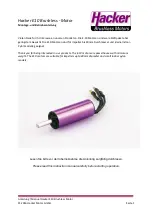
Predelivery Preparation
90-863758060 AUGUST 2006
Page 10A-5
For better acceleration, such as is needed for water skiing, the next lower pitch propeller
can be used. Care must be exercised when not pulling skiers to prevent over-revving the
engine. When cruising, the next highest pitch propeller should be used.
Because of the many variables of boat design, only testing will determine the best propeller
for a particular application. Just because a certain size propeller is used on a given model
of boat does not mean all boats like that model can use the same pitch propeller. Variances
in the boat and accessories can require that a different pitch propeller be used to get the
engine to operate a the maximum RPM of the specified RPM range. The following factors
may also cause a loss of engine RPM and require the use of a lower pitch or smaller
diameter propeller:
1. Warmer weather and greater humidity.
2. Operating in a higher elevation.
3. Operating with a damaged propeller or dirty boat bottom.
4. Operating with increased loads (accessories added).
The owner should be advised to recheck the WOT RPM after the first 50 hours of operation
to ensure that it is still within the specified range. By this time the engine has gone through
the break-in period.
IMPORTANT: The correct propeller must be used for optimum boat performance and
engine life.
Cruising RPM
Modern inboard engines operate at higher engine speeds than those produced just a few
years ago. This increased RPM along with better breathing is largely responsible for the
significant increase in horsepower of these new engines. Along with the higher WOT RPM
comes higher cruising RPM. This higher RPM is critical for optimum performance and
efficiency. The materials and design of the new engines allow these higher speeds without
a durability penalty. In fact, over-propping the boat to reduce the cruising RPM to previous
levels will increase the susceptibility to engine damage from detonation and pre-ignition.
The recommended cruising RPM ranges are listed in the following table.
Cruising RPM for Peak Efficiency
Model
RPM Range
5.7L
3200–3600
350 MAG MPI
3400–3800
350 MAG MPI Horizon
3400–3800
Black Scorpion
3600–3800
MX 6.2L MPI
3600–4000
MX 6.2L Black Scorpion
3600–4000
8.1S Horizon
3200–3600
8.1S HO
3400–3800
How Elevation and Climate Affect Performance
Elevation has a noticeable effect on the wide open throttle power of an engine. Since air
gets thinner as elevation increases, the engine begins to starve for air. Humidity, barometric
pressure, and temperature have a noticeable effect on the density of air; heat and humidity
thin the air. This condition can become particularly bothersome when the propeller testing
is done on a cool, dry day, then later on a hot, sultry day and the boat does not seem to
have the same performance.
Summary of Contents for 8.1S Horizon
Page 5: ...Page iv...
Page 19: ...Important Information Notes Page 1A 14 90 863758060 AUGUST 2006...
Page 53: ...Transmission and Drive Line Notes Page 2A 14 90 863758060 AUGUST 2006...
Page 59: ...Air Intake System Notes Page 4A 6 90 863758060 AUGUST 2006...
Page 119: ...Cooling System Notes Page 7A 22 90 863758060 AUGUST 2006...
Page 133: ...Electrical System Notes Page 8A 14 90 863758060 AUGUST 2006...
Page 153: ...Instrumentation and Controls Notes Page 9A 20 90 863758060 AUGUST 2006...
Page 163: ...Predelivery Preparation Notes Page 10A 10 90 863758060 AUGUST 2006...






































